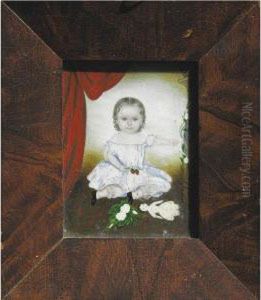Clarissa Peters Paintings
Clarissa Peters, also known after her marriage as Mrs. Moses B. Russell, was an American miniaturist born in 1809, in North Andover, Massachusetts. She was part of the early 19th-century movement of American miniaturists who specialized in watercolor portraits on ivory. Her work is notable for its delicate use of color and detailed rendering of subjects, contributing significantly to the American miniaturist tradition.
Clarissa Peters began her artistic career in her early twenties, a time when it was uncommon for women to pursue professional careers, especially in the arts. However, her talent and dedication to her craft quickly gained her recognition among her contemporaries. In 1839, she married Moses B. Russell, a fellow miniaturist, and the couple worked closely together, often collaborating on pieces. Despite the partnership, Clarissa maintained her own distinctive style and continued to receive commissions in her own right.
The Russells lived and worked in Boston, Massachusetts, where they became central figures in the city's burgeoning art scene. Clarissa's miniatures often depicted members of the Boston elite and were highly sought after for their exquisite detail and emotional depth. Her work was not limited to portraits; she also produced miniatures of landscapes and genre scenes, though these were less common.
Tragically, Clarissa Peters Russell's career was cut short by her untimely death in 1854, at the age of 45. Despite her relatively short life, she left behind a significant body of work that has continued to be appreciated for its beauty and craftsmanship. Her miniatures are held in several prestigious collections, including the Metropolitan Museum of Art and the Museum of Fine Arts, Boston, testifying to her enduring legacy in the field of American art.
Clarissa Peters Russell's contribution to American miniature painting is significant not only for her mastery of the form but also for her role as a pioneering woman artist in a male-dominated field. Her success and recognition in the competitive art world of the 19th century paved the way for future generations of women artists.
